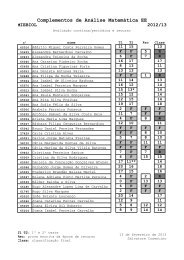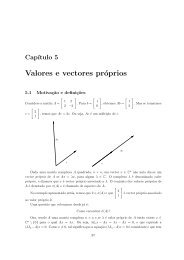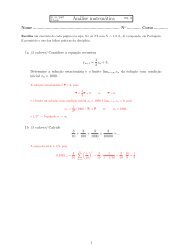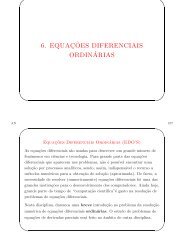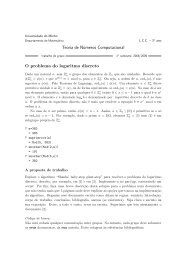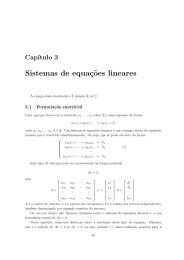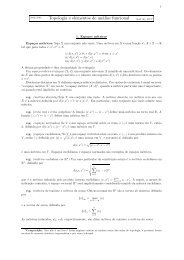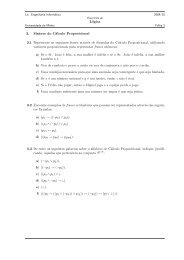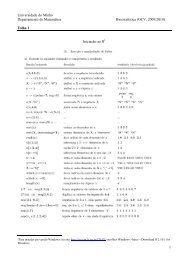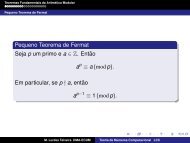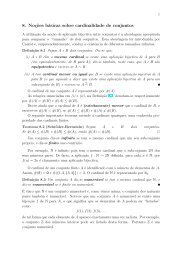My title - Departamento de Matemática da Universidade do Minho
My title - Departamento de Matemática da Universidade do Minho
My title - Departamento de Matemática da Universidade do Minho
You also want an ePaper? Increase the reach of your titles
YUMPU automatically turns print PDFs into web optimized ePapers that Google loves.
10 STATISTICAL DESCRIPTION OF ORBITS 65<br />
Lebesgue <strong>de</strong>nsity theorem.<br />
the <strong>de</strong>nsity<br />
Let A ⊂ R n be a Lebesgue-measurable set. For l-almos any x ∈ A<br />
l(A ∩ B ε (x))<br />
lim<br />
= 1<br />
ε→0 l(B ε (x))<br />
Kolmogorov extension. Let X be a finite space, equipped with the discrete topology, and<br />
let Σ + be the topological product X N = {x : N → X}, its point in<strong>de</strong>ntified with sequences x =<br />
(x 1 , x 2 ..., x n , ...) with x n ∈ X. Let C be the collection of cylin<strong>de</strong>rs of X, the subsets of the form<br />
C B = { x ∈ Σ + s.t. (x 1 , x 2 ..., x n ) ∈ B }<br />
with B an open subset of X n . Cylin<strong>de</strong>rs form a basis of the product topology of Σ + , which<br />
makes Σ + a compact metrizable space. In particular, the Borel σ-álgebra of Σ + is B = σ (C).<br />
Let µ 1 , µ 2 , µ 3 , . . . , µ n , . . . be probability measures <strong>de</strong>fined on the Borel sets of X, X 2 , . . . , X n , . . . ,<br />
respectively. The sequence (µ n ) is said consistent if<br />
µ n+1 (B × X) = µ n (B)<br />
for any n and any Borel subset B ⊂ X n . The (most elementary version of) Kolmogorov extension<br />
theorem says that<br />
Kolmogorov extension theorem. Given a consistent family of probability measures as above,<br />
there exists a unique probability measure µ, <strong>de</strong>fined on the Borel σ-algebra of Σ + , such that<br />
for any cilin<strong>de</strong>r C B .<br />
µ (C B ) = µ n (B)<br />
The proof consists in the following two steps. First, observe that cylin<strong>de</strong>rs form an algebra, and<br />
use consistency of the µ n ’s to verify that the formula above <strong>do</strong>es <strong>de</strong>fine a function µ : C → [0, 1] on<br />
cylin<strong>de</strong>rs (i.e. it <strong>do</strong>es not <strong>de</strong>pend on the different ways the same cylin<strong>de</strong>r may be presented) which<br />
is additive and properly normalized. Then, use compactness of X to check that µ is continuous at<br />
∅, in or<strong>de</strong>r to apply Carathéo<strong>do</strong>ry theorem. In<strong>de</strong>ed, let (A n ) be a sequence of cilin<strong>de</strong>rs such that<br />
A n ↓ ∅, and assume by contradiction that µ (A n ) > δ > 0 for any n. This implies that A n ≠ ∅ for<br />
any n, but, since the A n are compact, then the Cantor intersection theorem says that ∩ n A n ≠ ∅,<br />
contrary to the hypothesis.<br />
Kolmogorov theorem is the key tool in probability theory, since it allows one to construct measures<br />
which <strong>de</strong>scribe an infinite sequence of trials starting with some rule which gives information<br />
about the n-th trial given the knowledge of the first n−1. It actually works with much more general<br />
spaces and in a more general setting. Also, one can easily a<strong>da</strong>pt the construction to ∏ n∈N X n, the<br />
topological product of a countable family of finite spaces. In some precise sense, this is a universal<br />
mo<strong>de</strong>l of a dynamical system.<br />
If X = {0, 1}, then Σ + = X N is the state space of infinite Bernoulli trials with two possible<br />
outcomes: sucess and failure. Let µ 1 : P (X) → [0, 1] be a any probability measure, <strong>de</strong>fined by<br />
µ 1 ({1}) = p. Kolmogorov construction can be applied postulating the in<strong>de</strong>pen<strong>de</strong>nce of different<br />
trials, i.e. <strong>de</strong>claring that the family formed by the cilin<strong>de</strong>rs {x n = 1} is an in<strong>de</strong>pen<strong>de</strong>nt family,<br />
and giving measure p to each {x n = 1}. The resulting probability space (Σ + , B, µ) <strong>de</strong>scribes the<br />
infinite in<strong>de</strong>pen<strong>de</strong>nt Bernoulli trials. Of course, the very same construction can be ma<strong>de</strong> when X<br />
is a finite space with any finite numer z of elements.<br />
10.2 Transformations and invariant measures<br />
Measurable transformations. A transformation f : X → X of the measurable space (X, E)<br />
is said measurable if f −1 (A) ∈ E for any A ∈ E. A measurable transformation f is said an<br />
en<strong>do</strong>morphism of the measurable space, or an automorphism if it is invertible and its inverse is<br />
measurable too.



